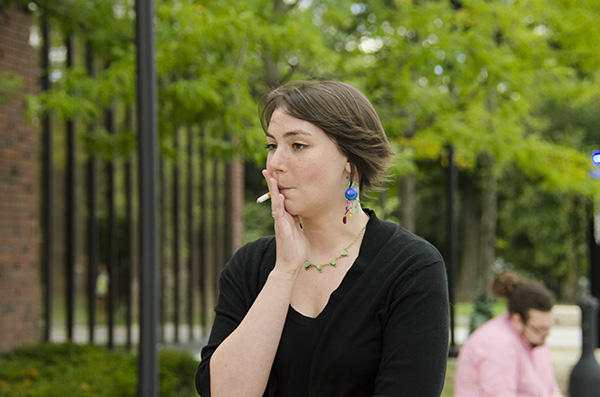

According to an email sent out by Michael G. Malloy, director of environmental health and safety, smoking is prohibited in all campus buildings, in SUNY motor vehicles, within 50 feet of building entrances with or without signage and in all exterior stairwells and any building roofs. That restriction comes from a New York state public health law, Malloy said.
The current smoking policy has gained momentum and support this year, with a campus wide email pushing students to adhere to the 50-feet rule. In terms of enforcement, Malloy said new employee orientations, face to face discussions and pleading to other community members to do their part and enforce the present smoking policy are strategies that work best.
Fire drills are also an important part of on-campus smoking awareness and policy enforcement, however SUNY New Paltz has had its share of real incidents, Malloy said.
“There have been a few [fires] from my recollection over the past six years,” Malloy said. “We have had many mulch fires from carelessly discarded butts, especially by the Lecture Center.”
In 2012, the SUNY Board of Trustees passed a resolution calling on all 64 SUNY campuses to become tobacco-free by January of 2014, according to the SUNY website. Some individual SUNY schools have already become smoke-free, but SUNY’s system-wide ban requires approval by the state legislature, which was not adopted in the 2013 legislative session in either the State Senate or Assembly.
“There are some campuses that have declared themselves smoke-free, but when you ask them how they are enforcing it, they throw their hands up in the air,” SUNY New Paltz President Donald Christian said in a previous interview with The New Paltz Oracle. “We have chosen to focus our efforts elsewhere instead of creating another regulation that people defy.”
However, according to Malloy, such a policy could mean a positive environmental impact.
“Some of the pros of a ban would be cleanliness of the campus,” said Malloy. “A smokefree campus with proper effective enforcement can make the aesthetics better without poorly discarded cigarette butts around campus.”
However fourth-year student Michelle Handler does not think the current policy is practical, let alone a campus wide ban.
“There’s no one to come and check if I’m smoking now [on campus],” Handler said. “As far as banning it, I know they did it at other SUNY schools. They took away the butt dispensers, but people did it anyway. And people would have to go to the edge of campus at night, which is dangerous.”
Malloy is very much aware of the problems with such a policy.
“There are some cons in that smokers would be forced to smoke outside the well lit and patrolled campus, especially at night, where the safe guards such as our blue light phones will not be accessible,” Malloy said. “As well as our neighbors, who might complain of carelessly discarded butts on their property. Smokers might also now have to hide in rooms to smoke and might defeat fire systems or set off fire alarms systems more frequently.”
In March 2012, three Student Association senators spearheaded a project to look into better ways of enforcing the already established policy at SUNY New Paltz. At the time, many students expressed interest in creating designated smoking areas on campus, which is another alternative to a ban, according to a previous article published in The New Paltz Oracle.
“We also need to recognize there are smokers who adhere to the policy and they should be thanked for participating as community members,” Malloy said. “I do not mean to vilify all smokers, there are smokers who follow the rules and do the right thing.”
Malloy has been campaigning to promote “community based enforcement” and it has been “an uphill battle,” but thinks momentum is shifting. Complaints regarding smoking by students in a given area should be referred to the Office of Student Affairs and will be handled through the student judicial process.
